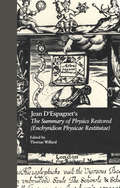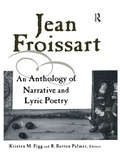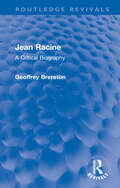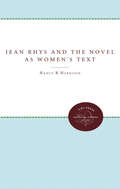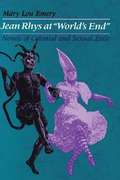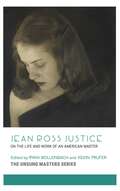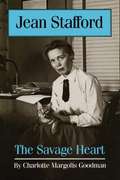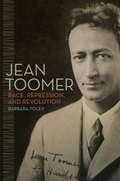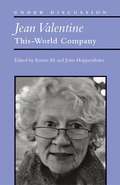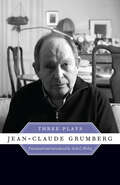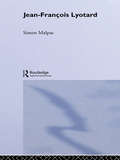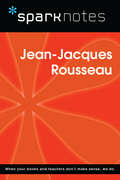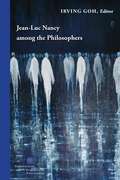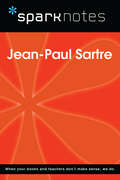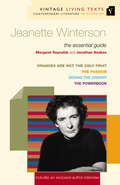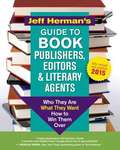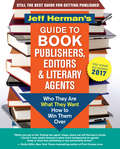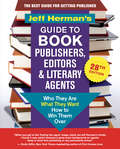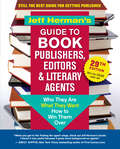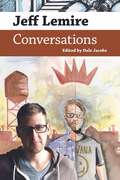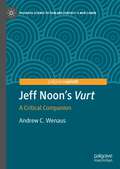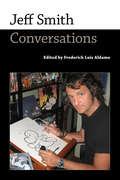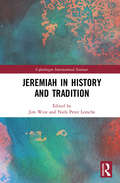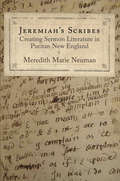- Table View
- List View
Jean D'Espagnet's The Summary of Physics Restored: The 1651 Translation with D'Espagnet's Arcanum (1650) (English Renaissance Hermeticism #7)
by Thomas WillardFirst published in 1999. Routledge is an imprint of Taylor & Francis, an informa company.
Jean Froissart: A Dual Language Anthology
by R. Barton Palmer Kristen M. FiggFirst published in 2002. Jean Froissart is probably the best known medieval historians. His Chronicle (of the Hundred Years War) is among the top ten historical works in western civilization. In his own time, though, he was better known as a poet. This is the first dual language anthology including excepts from Chroniques, as well as several of his verse and prose.
Jean Racine: A Critical Biography (Routledge Revivals)
by Geoffrey BreretonRacine the practising dramatist had been in some danger of being crowded out from the numerous books on his psychology and style. In this critical study of the man and his work, first published in 1951 and this slightly revised edition originally in 1973, Dr Brereton’s guiding principle has been to make the factual basis as accurate as it can be in the light of modern research. The result is the portrait of a sensitive and attractive figure which is none the worse for being shorn of certain legends.
Jean Rhys and the Novel As Women's Text
by Nancy R. HarrisonIs a woman's writing different from a man's? Many scholars -- and readers -- think so, even thought here has been little examination of the way women's novels enact the theories that women theorists have posited. In Jean Rhys and the Novel as Women's Text, Nancy Harrison makes an important contribution to the exchange of ideas on the writing practice of women and to the scholarship on Jean Rhys.Harrison determines what the form of a well-made women's novel discloses about the conditions of women's communication and the literary production that emerges from them. Devoting the first part of her book to theory and general commentary on Rhys's approach to writing, she then offers perceptive readings of Voyage in the Dark, an early Rhys novel, and Wide Sargasso Sea, Rhys's masterpiece written twenty-seven years later. She shows how Rhys uses the terms of a man's discourse, then introduces a woman's (or several women's) discourse as a compelling counterpoint that, in time, becomes prominent and gives each novel its thematic impact. In presenting a continuing dialogue with the dominant language and at the same time making explicit the place of a woman's own language, Rhys gives us a paradigm for a new and basically moral text.Originally published in 1988.A UNC Press Enduring Edition -- UNC Press Enduring Editions use the latest in digital technology to make available again books from our distinguished backlist that were previously out of print. These editions are published unaltered from the original, and are presented in affordable paperback formats, bringing readers both historical and cultural value.
Jean Rhys at "World's End": Novels of Colonial and Sexual Exile
by Mary Lou EmeryThe Caribbean Islands have long been an uneasy meeting place among indigenous peoples, white European colonists, and black slave populations. Tense oppositions in Caribbean culture-colonial vs. native, white vs. black, male conqueror vs. female subject-supply powerful themes and spark complex narrative experiments in the fiction of Dominica-born novelist Jean Rhys. In this pathfinding study, Mary Lou Emery focuses on Rhys's handling of these oppositions, using a Caribbean cultural perspective to replace the mainly European aesthetic, moral, and psychological standards that have served to misread and sometimes devalue Rhys's writing. Emery considers all five Rhys novels, beginning with Wide Sargasso Sea as the most explicitly Caribbean in its setting, in its participation in the culminating decades of a West Indian literary naissance, and most importantly, in its subversive transformation of European concepts of character. From a sociocultural perspective, she argues persuasively that the earlier novels-Voyage in the Dark, Quartet, After Leaving Mr. Mackenzie, and Good Morning, Midnight-should be read as emergent Caribbean fiction, written in tense dialogue with European modernism. Building on this thesis, she reveals how the apparent passivity, masochism, or silence of Rhys's female protagonists results from their doubly marginalized status as women and as subject peoples. Also, she explores how Rhys's women seek out alternative identities in dreamed of, magically realized, or chosen communities. These discoveries offer important insights on literary modernism, Caribbean fiction, and the formation of female identity.
Jean Ross Justice: On the Life and Work of an American Master (The Unsung Masters Series)
by Kevin Prufer Jean Ross Justice Ryan BollenbachThe wife of acclaimed poet Donald Justice, Jean Ross Justice spent much of her life in academic and literary circles. Though her work was overshadowed by that of her husband during her lifetime, this collection and accompanying commentary recognize her subtle brilliance. In "Double First Cousins," a young woman sets her life aside to help her ailing cousin and falls in love with her cousin's charming husband. In "The Next to Last Line" an accomplished poet appropriates a line written by one of her students. In "The Sky Fading Upward to Yellow" a woman ponders her friend's affair with a famous writer. Essays examine several of the stories in this collection and show why they endure.
Jean Stafford: The Savage Heart
by Charlotte Margolis GoodmanOne of America's best short story writers and author of three fine novels,Boston Adventure (1944), The Mountain Lion (1947), and The Catherine Wheel (1952), Jean Stafford has been rediscovered by another generation of readers and scholars. Although her novels and her Pulitzer Prize-winning short stories were widely read in the 1940s and 1950s, her fiction has received less critical attention than that of other distinguished contemporary American women writers such as Carson McCullers, Flannery O'Connor, and Eudora Welty. In this literary biography, Charlotte M. Goodman traces the life of the brilliant yet troubled Jean Stafford and reassesses her importance. Drawing on a wealth of original material, Goodman describes the vital connections between Stafford's life and her fiction. She discusses Stafford's difficult family relationships, her tempestuous first marriage to the poet Robert Lowell, her unresolved conflicts about gender roles, her alcoholism and bouts with depression-and her amazing ability to transform the chaotic details of her life into elegant works of fiction. These wonderfully crafted works offer insightful portraits of alienated and isolated characters, most of whom exemplify not only human estrangement in the modern world, but also the special difficulties of girls and women who refuse to play traditional roles. Goodman locates Jean Stafford within the literary world of the 1940s and 1950s. In her own right, and through her marriages to Robert Lowell, Life magazine editor Oliver Jensen, and journalist A. J. Liebling, Stafford associated with many of the major literary figures of her day, including the Southern Fugitives, the New York intellectual coterie, and writers for the New Yorker, to whichshe regularly contributed short stories. Goodman also describes Stafford's sustaining friendships with other women writers, such as Evelyn Scott and Caroline Gordon, and with her New Yorker editor, Katharine S. White. This highly readable biography will appeal to a wide audience interested in twentieth-century literature and the writing of women's lives.
Jean Toomer: Race, Repression, and Revolution
by Barbara FoleyThe 1923 publication of Cane established Jean Toomer as a modernist master and one of the key literary figures of the emerging Harlem Renaissance. Though critics and biographers alike have praised his artistic experimentation and unflinching eyewitness portraits of Jim Crow violence, few seem to recognize how much Toomer's interest in class struggle, catalyzed by the Russian Revolution and the post-World War One radical upsurge, situate his masterwork in its immediate historical context. In Jean Toomer: Race, Repression, and Revolution, Barbara Foley explores Toomer's political and intellectual connections with socialism, the New Negro movement, and the project of Young America. Examining his rarely scrutinized early creative and journalistic writings, as well as unpublished versions of his autobiography, she recreates the complex and contradictory consciousness that produced Cane. Foley's discussion of political repression runs parallel with a portrait of repression on a personal level. Examining family secrets heretofore unexplored in Toomer scholarship, she traces their sporadic surfacing in Cane. Toomer's text, she argues, exhibits a political unconscious that is at once public and private.
Jean Valentine: This-World Company
by John Ali Kazim HoppenthalerOver the course of more than four decades, contemporary American poet Jean Valentine has written eleven books of stunning, spirit-inflected poetry. This collection of essays, assembled over several years by Kazim Ali and John Hoppenthaler, brings together twenty-six pieces on all stages of Valentine's career by a range of poets, scholars, and admirers. Valentine's poetry has long been valued for its dreamlike qualities, its touches of the personal and the political, and its mesmerizing phrasing. Valentine is a National Book Award winner and was named the State Poet of New York in 2008. She has taught a number of popular workshops and has been awarded a Bunting Institute Fellowship, a Guggenheim Foundation Fellowship, and the Shelley Memorial Prize.
Jean-Claude Grumberg: Three Plays (Exploring Jewish Arts and Culture)
by Jean-Claude GrumbergWinner of seven Molières, the Pulitzer Prize of France, Jean-Claude Grumberg is one of France&’s leading dramatists and a distinguished voice of modern European Jewry after the Shoah. His success in portraying contemporary Parisian Jews on the stage represents a new development in European theater and a new aesthetic expression of European Jewish experience and sensibility of the Holocaust and its aftermath, a perspective quite different from either the American or the Israeli one. Grumberg&’s Jews are French to their fingertips, yet they have been made more consciously Jewish by the war and the difficulties of reintegrating into a society in which too many neighbors denounced them or ignored their pleas to save their children. Affirming the new status of Jewish culture, Grumberg&’s plays insist on the recognition of Jewish identity and uniqueness within the majority societies of Europe. This volume offers the first English translation of three of Grumberg&’s prize-winning plays: The Workplace (L&’Atelier, 1979), On the Way to the Promised Land (Vers toi Terre promise, 2006) and Mama&’s Coming Back, Poor Orphan (Maman revient, pauvre orphelin, 1994). Presented in the order of the history they record and steeped in Grumberg&’s personal experience and insights into contemporary Parisian life, these plays serve as documentary witnesses that begin with the immediate postwar reality and continue up to the end of the twentieth century. Seth Wolitz provides notes on the plays&’ themes, structures, characters, and settings, along with an introduction that discusses Grumberg&’s place within the emergence of French-Jewish drama and a translation of an interview with the playwright himself.
Jean-François Lyotard (Routledge Critical Thinkers)
by Simon MalpasJean-François Lyotard is one of the most celebrated proponents of what has become known as the 'postmodern'. More than almost any other contemporary theorist, he has explored the relations between knowledge, art, politics and history, in ways that offer radical new possibilities for thinking about modern culture. Simon Malpas introduces students to issues at the heart of Lyotard's work, including*modernity and the postmodern*the sublime*ethics*history and representation*art and the unpresentable*knowledge, the university and the future.Lyotard's work is impossible to dismiss or ignore for anybody who is serious about contemporary literature and culture, and this guide provides the ideal companion to the wide variety of his critical texts.
Jean-Jacques Rousseau (SparkNotes Philosophy Guide)
by SparkNotesJean-Jacques Rousseau (SparkNotes Philosophy Guide) Making the reading experience fun! SparkNotes Philosophy Guides are one-stop guides to the great works of philosophy–masterpieces that stand at the foundations of Western thought. Inside each Philosophy Guide you&’ll find insightful overviews of great philosophical works of the Western world.
Jean-Luc Nancy among the Philosophers (Perspectives in Continental Philosophy)
by Irving GohThis volume focuses on the relational aspect of Jean-Luc Nancy’s thinking. As Nancy himself showed, thinking might be a solitary activity but it is never singular in its dimension. Building on or breaking away from other thoughts, especially those by thinkers who had come before, thinking is always plural, relational. This “singular plural” dimension of thought in Nancy’s philosophical writings demands explication.In this book, some of today’s leading scholars in the theoretical humanities shed light on how Nancy’s thought both shares with and departs from Descartes, Hegel, Marx, Heidegger, Weil, Lacan, Merleau-Ponty, and Lyotard, elucidating “the sharing of voices,” in Nancy’s phrase, between Nancy and these thinkers.Contributors: Georges Van Den Abbeele, Emily Apter, Rodolphe Gasché, Werner Hamacher, Eleanor Kaufman, Marie-Eve Morin, Timothy Murray, Jean-Luc Nancy, and John H. Smith
Jean-Paul Sartre (SparkNotes Philosophy Guide)
by SparkNotesJean-Paul Sartre (SparkNotes Philosophy Guide) Making the reading experience fun! SparkNotes Philosophy Guides are one-stop guides to the great works of philosophy–masterpieces that stand at the foundations of Western thought. Inside each Philosophy Guide you&’ll find insightful overviews of great philosophical works of the Western world.
Jean-Paul Sartre: An Existential Odyssey With Jean-paul Sartre (Routledge Critical Thinkers)
by Christine DaigleA critical figure in twentieth-century literature and philosophy, Jean-Paul Sartre changed the course of critical thought, and claimed a new, important role for the intellectual. Christine Daigle sets Sartre’s thought in context, and considers a number of key ideas in detail, charting their impact and continuing influence, including: Sartre’s theories of consciousness, being and freedom as outlined in Being and Nothingness and other texts the ethics of authenticity and absolute responsibility concrete relations, sexual relationships and gender difference, focusing on the significance of the alienating look of the Other the social and political role of the author the legacy of Sartre’s theories and their relationship to structuralism and philosophy of mind. Introducing both literary and philosophical texts by Sartre, this volume makes Sartre’s ideas newly accessible to students of literary and cultural studies as well as to students of continental philosophy and French.
Jeanette Winterson: The Essential Guide (Vintage Living Texts #5)
by Margaret Reynolds Jonathan NoakesIn Vintage Living Texts, teachers and students will find the essential guide to the works of Jeanette Winterson. Vintage Living Texts is unique in that it offers an in-depth interview with Jeanette Winterson, relating specifically to the texts under discussion. This guide deals with Winterson's themes, genre and narrative technique, and a close reading of the texts will provide a rich source of ideas for intelligent and inventive ways of approaching the novels.
Jeff Herman's Guide to Book Publishers, Editors & Literary Agents
by Jeff HermanIf you want to get published, read this book! Jeff Herman's Guide unmasks nonsense, clears confusion, and unlocks secret doorways to success for new and veteran writers! This highly respected resource is used by publishing insiders everywhere and has been read by millions all over the world. Jeff Herman's Guide is the writer's best friend. It reveals the names, interests, and contact information of thousands of agents and editors. It presents invaluable information about more than 350 publishers and imprints (including Canadian and university presses), lists independent book editors who can help you make your work more publisher-friendly, and helps you spot scams. Jeff Herman's Guide unseals the truth about how to outsmart the gatekeepers, break through the barriers, and decipher the hidden codes to getting your book published. Countless writers have achieved their highest aspirations by following Herman's outside-the-box strategies. If you want to reach the top of your game and transform rejections into contracts, you need this book! Jeff Herman's Guide will educate you, inspire you, and become your virtual entourage at every step along the exhilarating journey to publication. Ask anyone in the book business, and they will refer you to Jeff Herman's Guide. NEW for 2015: Comprehensive index listing dozens of subjects and categories to help you find the perfect publisher or agent.
Jeff Herman's Guide to Book Publishers, Editors & Literary Agents 2032: Who They Are, What They Want, How to Win Them Over
by Jeff HermanStill the Best Guide for Getting Published If you want to get published, read this book! Comprehensive index lists dozens of subjects and categories to help you find the perfect publisher or agent. Jeff Herman's Guide unmasks nonsense, clears confusion, and unlocks secret doorways to success for new and veteran writers! This highly respected resource is used by publishing insiders everywhere and has been read by millions all over the world. Jeff Herman's Guide is the writer's best friend. It reveals the names, interests, and contact information of thousands of agents and editors. It presents invaluable information about more than 350 publishers and imprints (including Canadian and university presses), lists independent book editors who can help you make your work more publisher-friendly, and helps you spot scams. Jeff Herman's Guide unseals the truth about how to outsmart the gatekeepers, break through the barriers, and decipher the hidden codes to getting your book published. Countless writers have achieved their highest aspirations by following Herman's outside-the-box strategies. If you want to reach the top of your game and transform rejections into contracts, you need this book!
Jeff Herman's Guide to Book Publishers, Editors & Literary Agents, 28th edition: Who They Are, What They Want, How to Win Them Over
by Jeff HermanIf you want to get published, read this book! Jeff Herman’s Guide unmasks nonsense, clears confusion, and unlocks secret doorways to success for new and veteran writers! This highly respected resource is used by publishing insiders everywhere and has been read by millions all over the world. Jeff Herman’s Guide is the writer’s best friend. It reveals the names, interests, and contact information of hundreds of agents and editors. It presents invaluable information about 245 publishers and imprints, lists independent book editors who can help you make your work more publisher-friendly, and helps you spot scams. Jeff Herman’s Guide unseals the truth about how to outsmart the gatekeepers, break through the barriers, and decipher the hidden codes to getting your book published. Countless writers have achieved their highest aspirations by following Herman’s outside-the-box strategies. If you want to reach the top of your game and transform rejections into contracts, you need this book! Comprehensive index lists dozens of subjects and categories to help you find the perfect publisher or agent.
Jeff Herman’s Guide to Book Publishers, Editors & Literary Agents, 29th Edition: Who They Are, What They Want, How to Win Them Over
by Jeff HermanIf you want to get published, read this book! Jeff Herman’s Guide unmasks nonsense, clears confusion, and unlocks secret doorways to success for new and veteran writers! This highly respected resource is used by publishing insiders everywhere and has been read by millions all over the world. Countless writers have turned to this book to figure out how to decipher the hidden codes to getting published. It reveals: • tools to discern and exploit the rapidly changing publishing environment • the crucial differences between independent houses and the “Big 5” publishers • hard truths about self-publishing • names, interests, and contact information of hundreds of agents and editors • how writers unwittingly disqualify themselves from the consideration they deserve, and how to optimize chances with agents • critical thinking skills for outside-the-box publishing strategies • the nuts and bolts of superior query letters and proposals • how to spot and avoid ever-more-prevalent scams • the value of “book doctors” and when to consider hiring them • what to do — and not do — once you’ve got an editor or publisher interested Herman’s book remains the go-to guide for everything anyone ever wanted to know about book publishing. Comprehensive index lists dozens of subjects and categories to help you find the perfect publisher or agent.
Jeff Lemire: Conversations (Conversations with Comic Artists Series)
by Dale JacobsIn a 2019 interview with the webzine DC in the 80s, Jeff Lemire (b. 1976) discusses the comics he read as a child growing up in Essex County, Ontario—his early exposure to reprints of Silver Age DC material, how influential Crisis on Infinite Earths and DC’s Who’s Who were on him as a developing comics fan, his first reading of Watchmen and The Dark Knight Returns, and his transition to reading the first wave of Vertigo titles when he was sixteen. In other interviews, he describes discovering independent comics when he moved to Toronto, days of browsing comics at the Beguiling, and coming to understand what was possible in the medium of comics, lessons he would take to heart as he began to establish himself as a cartoonist. Many cartoonists deflect from questions about their history with comics and the influences of other artists, while others indulge the interviewer briefly before attempting to steer the questions in another direction. But Lemire, creator of Essex County Trilogy, Sweet Tooth, The Nobody, and Trillium, seems to bask in these discussions. Before he was ever a comics professional, he was a fan. What can be traced in these interviews is the story of the movement from comics fan to comics professional. In the twenty-nine interviews collected in Jeff Lemire: Conversations, readers see Lemire come to understand the process of collaboration, the balancing act involved in working for different kinds of comics publishers like DC and Marvel, the responsibilities involved in representing characters outside his own culture, and the possibilities that exist in the comics medium. We see him embrace a variety of genres, using each of them to explore the issues and themes most important to him. And we see a cartoonist and writer growing in confidence, a working professional coming into his own.
Jeff Noon's "Vurt": A Critical Companion (Palgrave Science Fiction and Fantasy: A New Canon)
by Andrew C. WenausThis book offers an examination of Jeff Noon’s iconoclastic debut novel, Vurt (1993). In this first book-length study of the novel, which includes an extended interview with Noon, Wenaus considers how Vurt complicates the process of literary canonization, its constructivist relationship to genre, its violent and oneiric setting of Manchester, its use of the Orphic myth as an archetype for the practice of literary collage and musical remix, and how the structural paradoxes of chaos and fractal geometry inform the novel’s content, form, and theme. Finally, Wenaus makes the case for Vurt’s ongoing relevance in the 21st century, an era increasingly characterized by neuro-totalitarianism, psychopolitics, and digital surveillance. With Vurt, Noon begins his project of rupturing feedback loops of control by breaking narrative habits and embracing the contingent and unpredictable. An inventive, energetic, and heartbreaking novel, Vurt is also an optimistic and heartfelt call for artists to actively create open futures.
Jeff Smith: Conversations (Conversations with Comic Artists Series)
by Frederick Luis AldamaFirst with his magisterial fantasy Bone to his mind-bending, time-warping sci-fi noir RASL, Paleolithic-set fantasy Tüki: Save the Humans, arthouse-styled superheroic miniseries Shazam!, and his latest children’s book Smiley’s Dream Book, Jeff Smith (b. 1960) has made an indelible mark on the comics industry. As a child, Smith was drawn to Charles Schulz’s Peanuts, Carl Barks’s Donald Duck, and Walt Kelly’s Pogo, and he began the daily practice of drawing his own stories. After writing his regular strip Thorn for The Ohio State University’s student paper, Smith worked in animation before creating, writing, and illustrating his runaway success, Bone. A comedic fantasy epic, Bone focuses on the Bone cousins, white, bald cartoon characters run out of their hometown, lost in a distant, mysterious valley. The self-published series ran from 1991 to 2004 and won numerous awards, including ten Eisner Awards. This career-spanning collection of interviews, ranging from 1999 to 2017, enables readers to follow along with Smith's development as an independent creator, writer, and illustrator.
Jeremiah in History and Tradition (Copenhagen International Seminar)
by Jim West Niels Peter LemcheJeremiah in History and Tradition examines aspects of the Book of Jeremiah from a variety of perspectives including historical, textual, redaction, and feminist criticism, as well as the history of its reception. The book looks afresh at the Book of Jeremiah through the lens of intertextuality and reception history in the broadest sense, exploring Jeremiah in its historical context as well as the later history and interpretation of the text, and also reconsidering aspects of the Book of Jeremiah’s traditions. This volume features essays from a unique assembly of scholars, both seasoned and new. It is divided into two parts: "Jeremiah in History", which explores a variety of readings of Jeremiah from the point of view of classical historical criticism; and "Jeremiah in Tradition", which discusses the portraits and use of both the book and the figure of Jeremiah in extra-biblical traditions. Offering challenging new theories, Jeremiah in History and Tradition is invaluable to scholars and students in the field of Biblical Studies. It is a useful resource for anyone working on the interpretation of the biblical text and the readings of the text of Jeremiah throughout history.
Jeremiah's Scribes
by Meredith Marie NeumanNew England Puritan sermon culture was primarily an oral phenomenon, and yet its literary production has been understood mainly through a print legacy. In Jeremiah's Scribes, Meredith Marie Neuman turns to the notes taken by Puritan auditors in the meetinghouse in order to fill out our sense of the lived experience of the sermon. By reconstructing the aural culture of sermons, Neuman shifts our attention from the pulpit to the pew to demonstrate the many ways in which sermon auditors helped to shape this dominant genre of Puritan New England.Tracing the material transmission of sermon texts by readers and writers, hearers and notetakers, Jeremiah's Scribes challenges the notion of stable authorship by individual ministers. Instead, Neuman illuminates a mode of textual production that pervaded communities and occurred in the overlapping media of print, manuscript, and speech. Even printed sermons, she demonstrates, bore the traces of their roots in the oral culture of the meetinghouse.Bringing material considerations to bear on anxieties over the perceived relationship between divine and human language, Jeremiah's Scribes broadens our understanding of all Puritan literature. Neuman examines the controlling logic of the sermon in relation to nonsermonic writing--such as conversion narrative--ultimately suggesting the fundamental permeability among disparate genres of Puritan writing.
